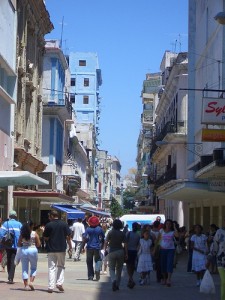 Beginning at Prado street and ending at Galiano, there is a five-block long pedestrian mall in the heart of Havana, replete with stores that take hard-currency or national pesos. Cafes, barber shops, ice cream parlors, markets, a cinema for children and a jewelry store in decline.
Beginning at Prado street and ending at Galiano, there is a five-block long pedestrian mall in the heart of Havana, replete with stores that take hard-currency or national pesos. Cafes, barber shops, ice cream parlors, markets, a cinema for children and a jewelry store in decline.
Throughout the year the boulevard is very busy. December, the month of summing up and hospitality, causes city dwellers to shop compulsively. It’s possible that in some of its businesses they can get what they want or need.
At the Belinda store, a group of ladies enter, looking for a set of sheets for their home. Their mouths drop open and they remain speechless when they learn the prices in inflated currency.
Nearby, some guys who are drunk, accompanied by cheerful black girls in the same condition, look both ways and surreptitiously enter by a rusty iron gate what were once the Duplex and Rex theaters. They empty their bladders full of beer, consumed in a nightclub called Palermo, where they usually will hook up with the old, cheap whores who don’t have the option of hooking up with a foreigner.
At the National Cabaret, where the boulevard starts at Prado Street, are a line of men in their fifties and a group of young mestizo girls, with the typical body language of females seeking pleasure, trying to find some “Temba” (men in their fifties) to pay the entry fee to the nightclub. The Disco Temba, as it is known, opens at 4 pm.
A stone’s throw away at the gates of the Hotel Inglaterra, Nordic ‘Vikings’ and fat ‘Iberians’ drink daiquiris, accompanied by tapas of ham, cheese, and olives. They listen raptly to a bad version of Chan-Chan by Compay Segundo. Inside the hotel, a Japanese girl with teenage acne complains in English to a clerk about how expensive Internet service is: a card costs 6 CUC per hour. What shall we Cubans say?
Evening falls and the comings and goings of hurrying people increase. To alleviate the thirst caused by the heat from this end-of-year fire, people drink bottled soft drinks, locally produced, at 5 pesos a bottle. In a kiosk they sell unwrapped bread, exposed to the air, with the appropriate dose of microbes; bread with either pork, ham, or a cheese with a terrible smell.
Wherever you sit, to take a drink, or eat a serving of fried rice or a piece of smoked chicken, you are approached by dirty, mangy dogs, which with pitiful faces beg you to give them your leftovers. They are part of the army of hungry dogs that roam around the entire city.
Beggars also do their part in the streets of downtown Havana. Some shamelessly and even aggressively ask you for money. Others, with the picture of a saint, usually St. Lazarus, ask you for alms, “preferably in hard currency.”
If you look like you have a foolish face, a crook will try to separate you from your money. You can find everything in the Boulevard of San Rafael. Schemes are constantly hatched and if you don’t look like a cop in civilian clothes, you can buy a gram of coke for 35 CUC or a Creole marijuana cigarette for 25 pesos.
The cobblestone streets are painted with large white squares, surrounded by pots with withered plants that the state gardeners do not look after, disgusted by their low pay.
Now at the far end, at the corner of Galiano and San Rafael, a park is a reminder that in this place once stood El Encanto, one of the most chic department stores in Havana. It was devoured by fire on April 13, 1961, as part of the sabotage before the Bay of Pigs invasion. There were 18 injuries and one fatality, Fe del Valle, the head of the El Encanto’s children’s department.
This story is not known to the children, whites, blacks and mestizos who play soccer with a deflated balloon. A black boy pulls off feints incredible for his age, barefoot and with a faded Kaká T-shirt. His fans, sitting on a wall, applaud the small Cuban Pelé.
Maybe the Boulevard San Rafael does not have the charm of Paris or Barcelona. But it is the only one in Havana: meeting point for Havanans, nostalgia for exiles, and headquarters of private guest houses for outsiders. If you pass through Havana, be sure to visit.
Ivan Garcia
Translated by: Tomás A.
